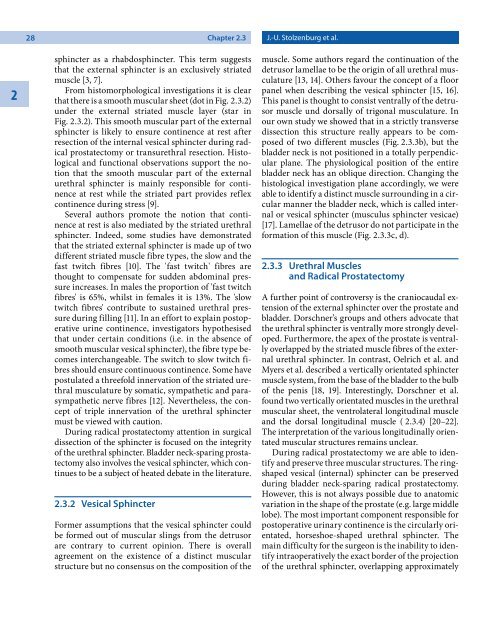7 - E-Lib FK UWKS
7 - E-Lib FK UWKS
7 - E-Lib FK UWKS
You also want an ePaper? Increase the reach of your titles
YUMPU automatically turns print PDFs into web optimized ePapers that Google loves.
2<br />
28<br />
sphincter as a rhabdosphincter. This term suggests<br />
that the external sphincter is an exclusively striated<br />
muscle [3, 7].<br />
From histomorphological investigations it is clear<br />
that there is a smooth muscular sheet (dot in Fig. 2.3.2)<br />
under the external striated muscle layer (star in<br />
Fig. 2.3.2). This smooth muscular part of the external<br />
sphincter is likely to ensure continence at rest after<br />
resection of the internal vesical sphincter during radical<br />
prostatectomy or transurethral resection. Histological<br />
and functional observations support the notion<br />
that the smooth muscular part of the external<br />
urethral sphincter is mainly responsible for continence<br />
at rest while the striated part provides reflex<br />
continence during stress [9].<br />
Several authors promote the notion that continence<br />
at rest is also mediated by the striated urethral<br />
sphincter. Indeed, some studies have demonstrated<br />
that the striated external sphincter is made up of two<br />
different striated muscle fibre types, the slow and the<br />
fast twitch fibres [10]. The 'fast twitch' fibres are<br />
thought to compensate for sudden abdominal pressure<br />
increases. In males the proportion of 'fast twitch<br />
fibres' is 65%, whilst in females it is 13%. The 'slow<br />
twitch fibres' contribute to sustained urethral pressure<br />
during filling [11]. In an effort to explain postoperative<br />
urine continence, investigators hypothesised<br />
that under certain conditions (i.e. in the absence of<br />
smooth muscular vesical sphincter), the fibre type becomes<br />
interchangeable. The switch to slow twitch fibres<br />
should ensure continuous continence. Some have<br />
postulated a threefold innervation of the striated urethral<br />
musculature by somatic, sympathetic and parasympathetic<br />
nerve fibres [12]. Nevertheless, the concept<br />
of triple innervation of the urethral sphincter<br />
must be viewed with caution.<br />
During radical prostatectomy attention in surgical<br />
dissection of the sphincter is focused on the integrity<br />
of the urethral sphincter. Bladder neck-sparing prostatectomy<br />
also involves the vesical sphincter, which continues<br />
to be a subject of heated debate in the literature.<br />
2.3.2 Vesical Sphincter<br />
Former assumptions that the vesical sphincter could<br />
be formed out of muscular slings from the detrusor<br />
are contrary to current opinion. There is overall<br />
agreement on the existence of a distinct muscular<br />
structure but no consensus on the composition of the<br />
Chapter 2.3 J.-U. Stolzenburg et al.<br />
muscle. Some authors regard the continuation of the<br />
detrusor lamellae to be the origin of all urethral musculature<br />
[13, 14]. Others favour the concept of a floor<br />
panel when describing the vesical sphincter [15, 16].<br />
This panel is thought to consist ventrally of the detrusor<br />
muscle und dorsally of trigonal musculature. In<br />
our own study we showed that in a strictly transverse<br />
dissection this structure really appears to be composed<br />
of two different muscles (Fig. 2.3.3b), but the<br />
bladder neck is not positioned in a totally perpendicular<br />
plane. The physiological position of the entire<br />
bladder neck has an oblique direction. Changing the<br />
histological investigation plane accordingly, we were<br />
able to identify a distinct muscle surrounding in a circular<br />
manner the bladder neck, which is called internal<br />
or vesical sphincter (musculus sphincter vesicae)<br />
[17]. Lamellae of the detrusor do not participate in the<br />
formation of this muscle (Fig. 2.3.3c, d).<br />
2.3.3 Urethral Muscles<br />
2.3.3 and Radical Prostatectomy<br />
A further point of controversy is the craniocaudal extension<br />
of the external sphincter over the prostate and<br />
bladder. Dorschner’s groups and others advocate that<br />
the urethral sphincter is ventrally more strongly developed.<br />
Furthermore, the apex of the prostate is ventrally<br />
overlapped by the striated muscle fibres of the external<br />
urethral sphincter. In contrast, Oelrich et al. and<br />
Myers et al. described a vertically orientated sphincter<br />
muscle system, from the base of the bladder to the bulb<br />
of the penis [18, 19]. Interestingly, Dorschner et al.<br />
found two vertically orientated muscles in the urethral<br />
muscular sheet, the ventrolateral longitudinal muscle<br />
and the dorsal longitudinal muscle ( 2.3.4) [20–22].<br />
The interpretation of the various longitudinally orientated<br />
muscular structures remains unclear.<br />
During radical prostatectomy we are able to identify<br />
and preserve three muscular structures. The ringshaped<br />
vesical (internal) sphincter can be preserved<br />
during bladder neck-sparing radical prostatectomy.<br />
However, this is not always possible due to anatomic<br />
variation in the shape of the prostate (e.g. large middle<br />
lobe). The most important component responsible for<br />
postoperative urinary continence is the circularly orientated,<br />
horseshoe-shaped urethral sphincter. The<br />
main difficulty for the surgeon is the inability to identify<br />
intraoperatively the exact border of the projection<br />
of the urethral sphincter, overlapping approximately











![SISTEM SENSORY [Compatibility Mode].pdf](https://img.yumpu.com/20667975/1/190x245/sistem-sensory-compatibility-modepdf.jpg?quality=85)





